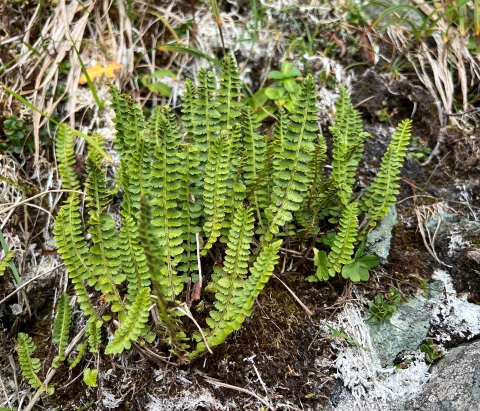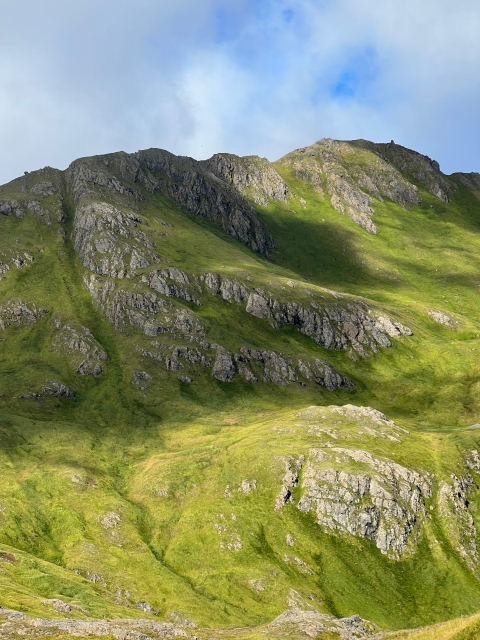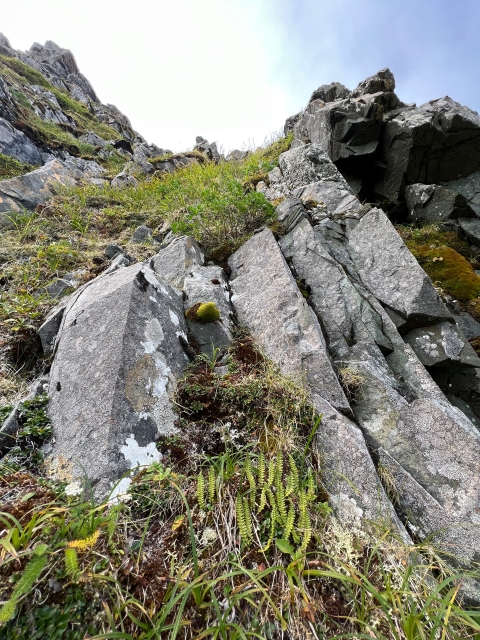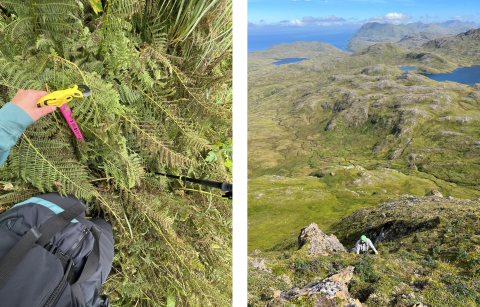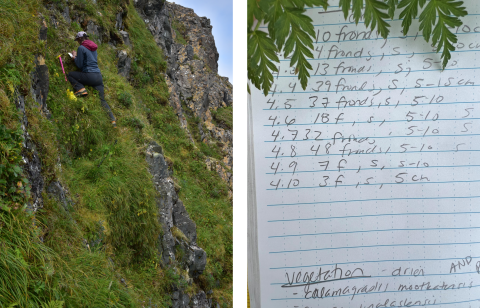I see Hunter wave his arms in the air and shout, “I found it!” Leah and I carefully traverse the slick, steep, rocky slope to join him. A perfect, tiny fern pokes through the grass at the base of a cliff. We grin at one another as it dawns on us: We’ve found the missing population. We are three of five people to have been here, standing with these ferns at the edge of the Aleutian Chain in Alaska Maritime National Wildlife Refuge.
Adak Island is unique. The grasses sparkle and glisten in the wind. The mountains loom large, steeply climbing out of the ocean. Islands in the offing float atop the horizon line.
This backdrop is home to Alaska’s only endangered plant: the Aleutian shield fern (Polystichum aleuticum). Why is it endangered? Because it only grows at four locations on this island, and that’s it. Nowhere else in the world.
We fly into 170 mile per hour headwinds to get to Adak Island. Hunter, Leah, and I step off the plane expecting the “Adak Special”: horizontal rain. Instead, we are greeted with sunshine, 60-degree temperatures, and dare I say… no wind. In one hour, the hunt for ferns begins.
Walter Eyerdam first documented the Aleutian shield fern in 1932 on Adak Island’s neighbor, Atka Island. But since then, despite numerous searches, nobody has found it there again. Thus, nearly one hundred years ago, the quest to find the Aleutian shield fern was born.
The directions are scrawled on a hand drawn map from a biologist in the 1980s. It includes compass bearings and hand-written notes to “gradually climb” and, miles later, “continue gradual climb.” My personal favorite instruction: “Those cliffs. That’s where you’re going. Are you sucking wind yet?”. Thank you, Gerald Tande. No, actually, thank you, because our GPS coordinates are proving inaccurate.
It wasn’t until 1975 that David Smith and others discovered a population of the missing Aleutian shield fern on Adak Island. It was the first successful fern quest in nearly 50 years, and they only counted seven lonely plants. Then, in 1988, Sandy Talbot discovered a second population on Adak. Botantist Gerald Tande mapped the two known populations in 1989, creating a treasure map for future generations to follow.
For 10 days, a wisp of a thought kept tumbling through my head. “This is the weirdest conglomeration of activities I have trained for.” I moved to Alaska to work as a glacier guide. I have spent the last five years exploring my interests in botany, mountain running, wildlife management, and environmental education. Surveying ferns on cliffs with my pink mountaineering axe and ice climbing boots felt… so right.
Sandy Talbot returned to Adak alongside her partner Steve Talbot in the 1990s and, over the next 15 years, found two additional fern populations. By the turn of the century, scientists were aware of four known populations and approximately 131 total plants. It is possible that more Aleutian shield ferns grow on Adak and the surrounding islands, escaping detection.
As we search the island, the task’s immenseness strikes me. There is so much potential habitat here. How could one rule out the possibility of there being more ferns? For the dedicated, the quest to find more ferns will likely continue. Just like buried treasure, they may exist. Hidden in the next cliff. Up on the next mountain. Sprouting through grass on a rocky cliffside, awaiting biologists at the end of their journey.
The four known populations of Aleutian shield ferns had not been surveyed in their entirety since the early 2000s. Why? The tiny fern grows in gnarly terrain: Slick, steep cliff bands high up in the mountains of a remote island. Biologists visiting these sites need to be extremely careful not to fall, and then, not to step on this rare species. The weather is a huge factor in the success of quests.
In 2022, thanks to good weather and great documentation by our predecessors, our team located all four Aleutian shield fern populations and completed the first count in 20 years.
I sat in the Adak airport for eight hours, hoping our delayed plane would make it to the island. I flipped through my muddy, vegetation-stained journal. This fern quest is coming to a close. Yet, I know that Adak and the other Aleutian Islands will continue to call to me. Beckoning me to go on future quests.

